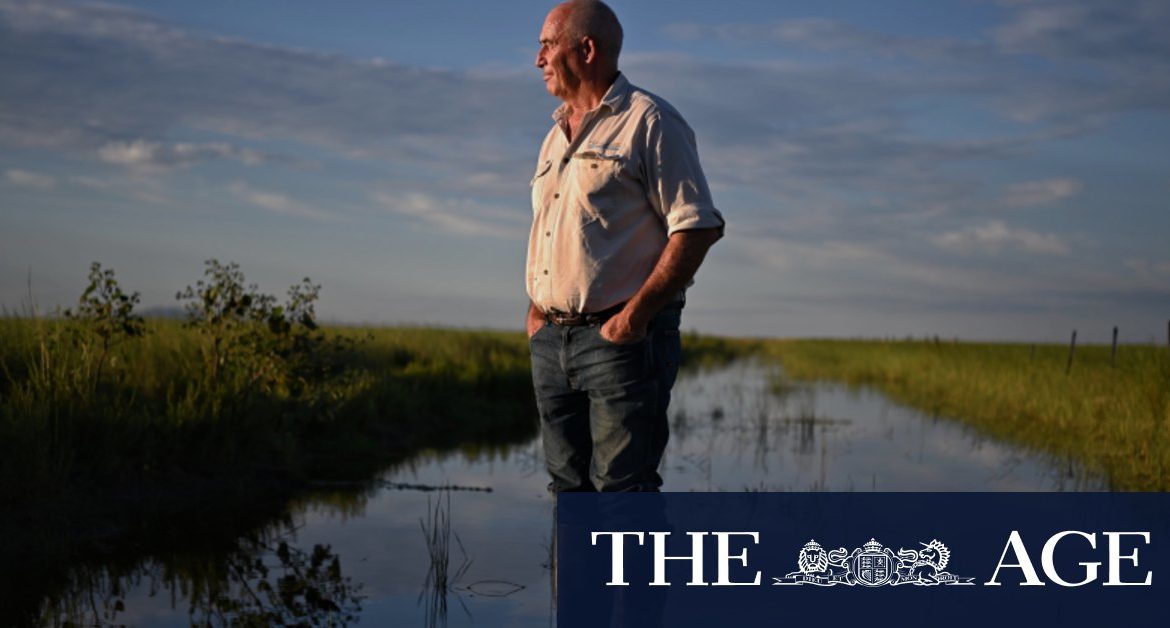On a summer’s evening, as the setting sun paints a flock of straw-necked ibises a glowing pink as they wing their way over Lake Cowal, it’s not hard to imagine Mal Carnegie has landed a dream job.
As manager of a conservation centre monitoring NSW’s largest inland natural freshwater lake, the 56-year old gets to introduce visitors to one of Australia’s greatest “boom-bust” wildlife systems that has thrilled him all his life.
Not that it was always as placid as it was earlier this week for visitors, with a colony of pelicans keeping a wary distance and the odd swamp harrier stirring magpie geese into a nervous cackle.
Loading
Lake Cowal, wedged between West Wyalong and Forbes on the Lachlan River in central NSW, was “a mecca for duck shooting” before it was banned 25 years ago, Carnegie says. “We’d have thousands of people here on the opening day.
“Just before sunrise, there would always be one person who fired the first shot, and then they’d all go,” he says. “It was like World War 3.”
The reprieve, plus the return of water, triggered a boom in biodiversity last year with bird numbers alone swelling to 115,000. Some 36 species were identified in the annual count led by University of NSW’s Richard Kingsford.
Now, though, a war of a different nature is under way. It potentially has a much greater and permanent toll for the wildlife of Lake Cowal and other Lachlan Valley wetlands.
As part of 2019 election campaign, the Berejiklian government pledged to lift the Wyangala Dam by 10 metres, effectively increasing NSW’s second-oldest irrigation reservoir by half to 1867 gigalitres.
Mal Carnegie, manager of the Lake Cowal Conservation Centre, is concerned about what a project to lift the Wyangala Dam wall in central NSW will mean for the lake’s wildlife.Credit:Nick Moir
Loading
The price tag was $650 million at the time, to be split equally with federal Coalition counterparts, the Morrison government. Since then, as this masthead has reported, internal NSW documents show that bill has jumped to as much as $2.1 billion.
The battles being waged include those within the corridors of the treasuries over how to fund the most costly water project in the Murray-Darling Basin. Another pits farming groups that clutch at greater water security in a warming and drying climate, with conservationists who fear yet another threat to already stressed ecosystems.
Unhelpful to the governments’ case is the latest leaked NSW Cabinet document. The Department of Industry’s “Incoming Government Brief” for regional water is scathing of the project, declaring it will require as much as 80 per cent of the costs to be subsidised “given the small net benefits”.
It says the Wyangala dam “has historically rarely filled to capacity”, with data showing it has done so just seven times since 1974. The most recent spill events came in 2000, 2012 and 2016.
Loading
“Expanding on the dam’s capacity is not expected to translate to higher average water allocations or significantly increased drought resilience,” the document states.
Early modelling indicates average water allocations as a percentage of licence entitlement will only rise from 37 per cent to 42 per cent. However, “this quantum of increase may not prove large enough to support significant industry growth or development for the area”, the document says.
This has not swayed NSW Water Minister Melinda Pavey who is adamant the project must proceed at the very least to secure water for towns like Forbes and Cowra.
“I made it clear when I came into this portfolio, we are building dams,” Pavey says. “For too long successive NSW departments have had an aversion to building water infrastructure, and previous governments have been allergic to investing in water security infrastructure.”
One reason to proceed is that modelling of climate change means “we need policy reforms and infrastructure projects”, she says.
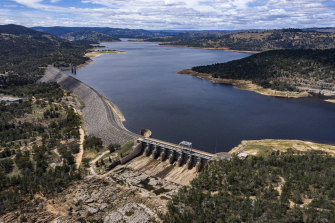
Wyangala Dam in central NSW is currently about 60 per cent full. The federal and NSW governments want to increase the dam’s capacity to boost water security in the Lachlan Valley, although a cabinet document suggests the gains will not be significant despite the hefty price tag. Credit:Nick Moir
A spokeswoman for the department responsible for the briefing said the project was “critical infrastructure and the government is working on the preliminary investigations and a business case to determine the final cost of the project”.
Loading
Her funding counterpart at the federal Department of Infrastructure said it was still waiting for the “detailed business case” which it expects to be finalised this year. Requests for more than the initial $325 million funding “will be considered on its merits by the Australian Government at that time”, the spokeswoman said.
One dam analyst says the public had reason to be concerned about big projects because of “a lack of public availability of the documents, business cases and due process”.
“In Australia, we are in danger of reverting to a 1950s mentality. We must be careful about harnessing water, harnessing nature. We have to carefully consider the benefits, the costs, and the risks,” the analyst said.
“Cost blowouts are almost always the norm – it’s a narrative the world over. In Australia, the median is a 48 per cent overrun,” the expert said. “The environmental effects are almost always under-estimated and there is a risk of the benefits being over-estimated.”

Patrick Brown, a civil engineer, argues the cost of the dam wall project at Wyangala is unlikely to be justified given the minimal increase in security for downstream water users.Credit:Nick Moir
Patrick Brown is a civil engineer who has worked for Doctors with Borders and is now with consultants Slattery & Johnson. As the author of an independent engineer’s report on the project he says the plan to lift Wyangala’s wall from 85 metres to 95 metres and widened by 110 metres brings many challenges.
For one thing, the expansion will need 1.4 million cubic metres of rockfill and require more than 40,000 truck movements. If as expected the project takes four years, the haulage amounts to one truck movement on average every 16 minutes, nine-hours-a-day, six-days-a-week, he says.
“A quarry that supplied the existing embankment is likely to be suitable. To access that material, though, it means the dam will have cut by half or more its allowable capacity during those years.
“You still need to have ‘airspace’ in the dam’ in case there’s a flood,” Brown says, standing beside the existing wall.
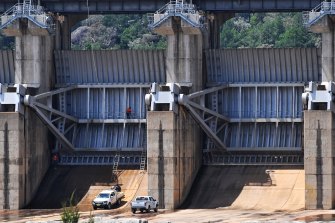
Work crews at the gates of Wyangala Dam: the business case for lifting the wall is yet to be made public.Credit:Nick Moir
A further issue is that a cap on water extraction has been in place for the Lachlan Valley since the mid-1990s. For towns or other customers such as gold mines to get more water means “you will have to take that water from another user”, Brown says.
However, Mary Ewing, executive officer of Lachlan Valley Water, a body representing irrigators, is confident the higher dam wall “will aid water security in the valley”.
“We’ve had highly variable inflows, particularly over the last 20 years,” she says, adding the need to increase reliability may only increase with climate change further altering rainfall patterns and raising temperatures. “If what we’re seeing is less reliable supply in the future, we need to plan for it well in advance.”
Ewing is also eager to see the business case, including the benefits of flood mitigation from a bigger dam. She notes the big flood in 2016 cut the Newell Highway for six weeks, hit local businesses and wiped $530 million off crop values in the Lachlan and Macquarie valleys.
Cowra mayor Bill West also backs increased capacity for Wyangala but does not anticipate “any direct contribution from Council”.
“Council supports the increased capacity of Wyangala Dam and would see it as a generational opportunity to create more water security and greater certainty for all those who rely on water in the Lachlan Valley,” West says.
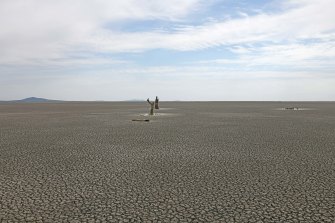
Dry times: Lake Cowal is an ephemeral lake and dries out completely at times. This image is from February 2019.Credit:Mal Carnegie, Lake Cowal Conservation Centre
Stuart Khan is a Professor at the University of NSW’s School of Civil and Environmental Engineering and an advisor to the National Water Grid Authority. He says dams have played “a very important role in making Australian towns and cities viable”, and the development of stable agricultural industries.
“It’s entirely understandable that people associate the construction of dams with nation-building and progress,” he says. “This appeals to politicians and this is why so many politicians wish to be seen as dam builders.”
“Still, best practice should be that all options are considered when deciding what project should proceed.
“This should include the construction of new dams, but alongside other means of addressing water needs, such as desalination and recycling, and also non-infrastructure solutions, such as adjusting water allocations or community water restrictions,” Khan says.
The Commonwealth Environmental Water Office (CEWO) and the Murray-Darling Basin Authority are among the agencies concerned about what a bigger dam will mean for the environment.
“A raised Wyangala Dam has the potential to significantly alter the river and floodplain hydrology and hence change the ecology downstream,” a CEWO spokesman says. “No detail has been provided by the project proponent, WaterNSW, on the proposed operating rules for the enlarged dam, which would provide a basis for assessment of the impacts.”
A Murray-Darling Basin Authority spokeswoman echoes the view: “Any new dams or expanded dams within the Basin need to be operated in a way that is consistent with the Basin Plan”.
“This includes keeping within the sustainable diversion limits and ensuring there is no net reduction in the protection of Planned Environmental Water.”
Kingsford, who heads UNSW’s Centre for Ecosystem Science, says one consequence of trapping more floodwaters is downstream wetlands such as the Great Cumbung Swamp and Lake Cowal that require big flows to trigger large breeding events will be less likely to receive them.
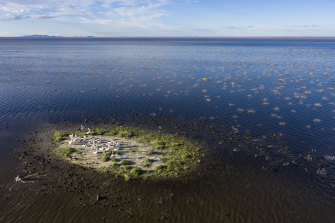
A flock of pelicans occupy a dry patch in the middle of Lake Cowal, the second largest inland freshwater lake in NSW.Credit:Nick Moir
Lake Cowal “is a magnificent lake for its biodiversity”, he says. It often boasts species like the freckled duck and is an important area for the endangered Australasian bittern.
“It has an incredible diversity of waterbirds because it has so much habitat variety, with open water areas and reeds,” Kingsford says. “It can build up large numbers of fish which attract pelicans in their thousands.”
Loading
“It is highly dependent on the Lachlan and so an enlarged Wyangala will have a major impact on its biodiversity including its threatened species.”
Carnegie, a third-generation farmer himself until the nearby Evolution gold mine forced him off his land, says 10,000 people visited his lake-side centre in 2019 before COVID-19 hit tourism. Numbers will likely resume their growth provided the lake can continue to fill and drain.
“People are just interested in a landscape that can change [like this one] as naturally as it can be in this day and age,” he says.
“We need those big floods to make a big impact and the dam project reduces the likelihood of getting that event.”
Start your day informed
Our Morning Edition newsletter is a curated guide to the most important and interesting stories, analysis and insights. Sign up to The Sydney Morning Herald’s newsletter here.
Peter Hannam writes on environment issues for The Sydney Morning Herald and The Age.
Most Viewed in Environment
Loading

